Sugar is everywhere you look—whether it’s in your morning coffee, those convenient packaged snacks, or even in foods you might not expect, like sauces and breads. While our bodies do need some sugar for energy, overdoing it can lead to a range of health problems, from weight gain to diabetes. That’s why figuring out how much sugar is actually healthy to consume in a day has become such a crucial question for anyone aiming to improve their health.
The tricky part? Most people end up consuming way more sugar than they realise. Those sneaky hidden sugars in processed foods and drinks can easily push you over the daily limit without you even noticing. But here’s the silver lining: once you get a handle on the right numbers and make a few smart swaps, managing your sugar intake becomes a lot easier. In this blog, we’re going to dive into just how much sugar you really need in a day, what health experts suggest, and how you can keep your sugar levels in check.
By the time you finish reading, you’ll have a solid understanding of safe sugar limits, where hidden sugars lurk, and practical tips to cut back on your daily sugar intake without feeling like you’re missing out.
You can Also Listen to our Podcast here,
Why Sugar Intake Matters? 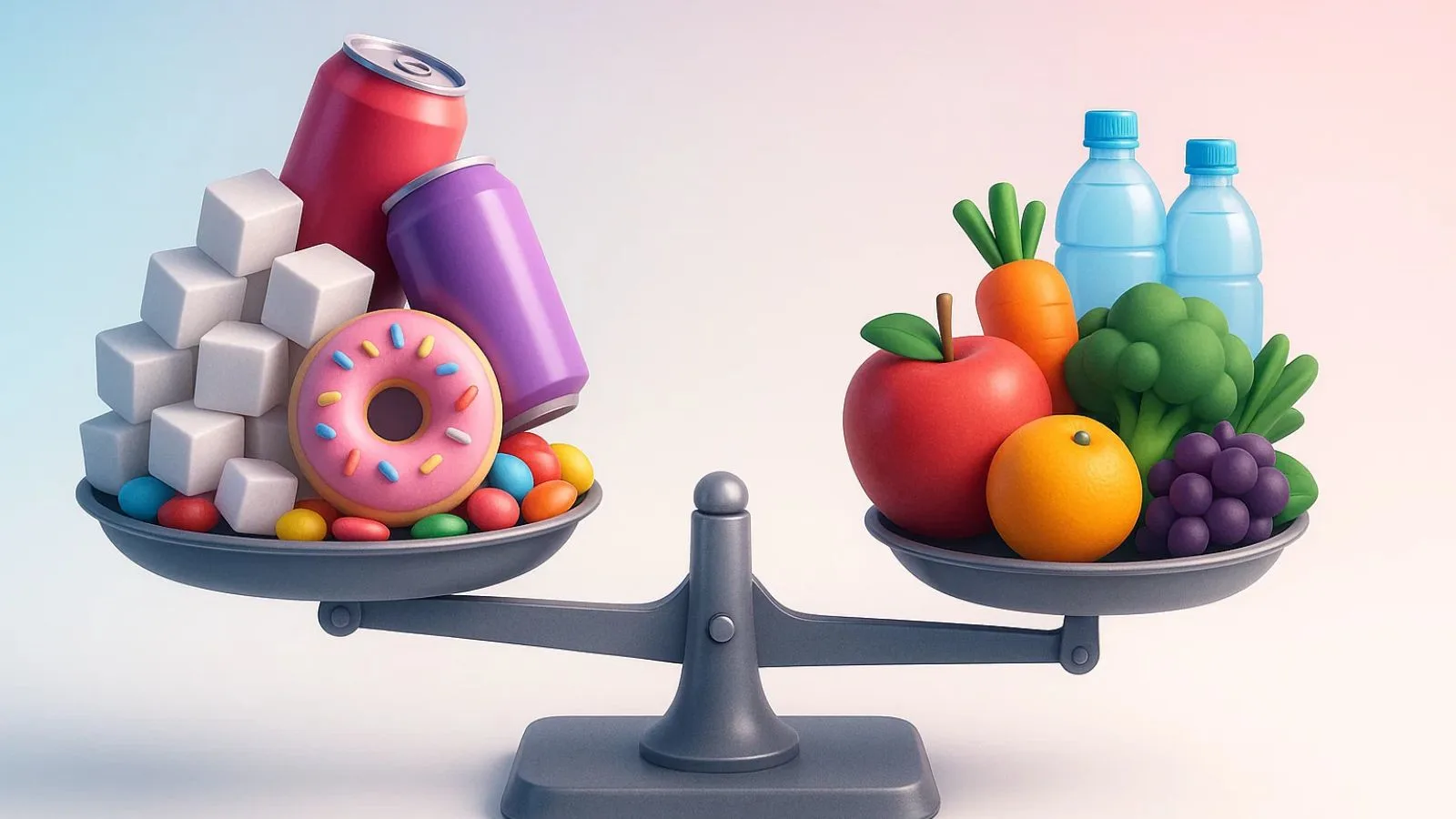
Sugar is pretty essential for our bodies. It provides us with a quick energy boost, powers our brains, and helps us get through our daily activities. When consumed in moderation, sugar isn’t a bad thing; the trouble starts when we overindulge.
These days, most people tend to eat way more sugar than they actually need. This excess can lead to weight gain, spikes in blood sugar, and eventually serious health issues like type 2 diabetes, heart disease, and dental problems. That’s why it’s crucial to understand how much sugar is appropriate to consume each day.
Too much sugar can also mess with your energy levels. Sure, it might give you a quick lift, but the crash that follows can leave you feeling drained and craving even more sweets. Over time, this cycle can make it tough to stick to a balanced diet and maintain a healthy weight.
In a nutshell, sugar itself isn’t the bad guy; it’s the overconsumption that leads to health problems. Keeping track of your daily sugar intake can help you enjoy your food while also looking out for your overall health.
Also Read,
How Much Sugar in a Day Is Recommended?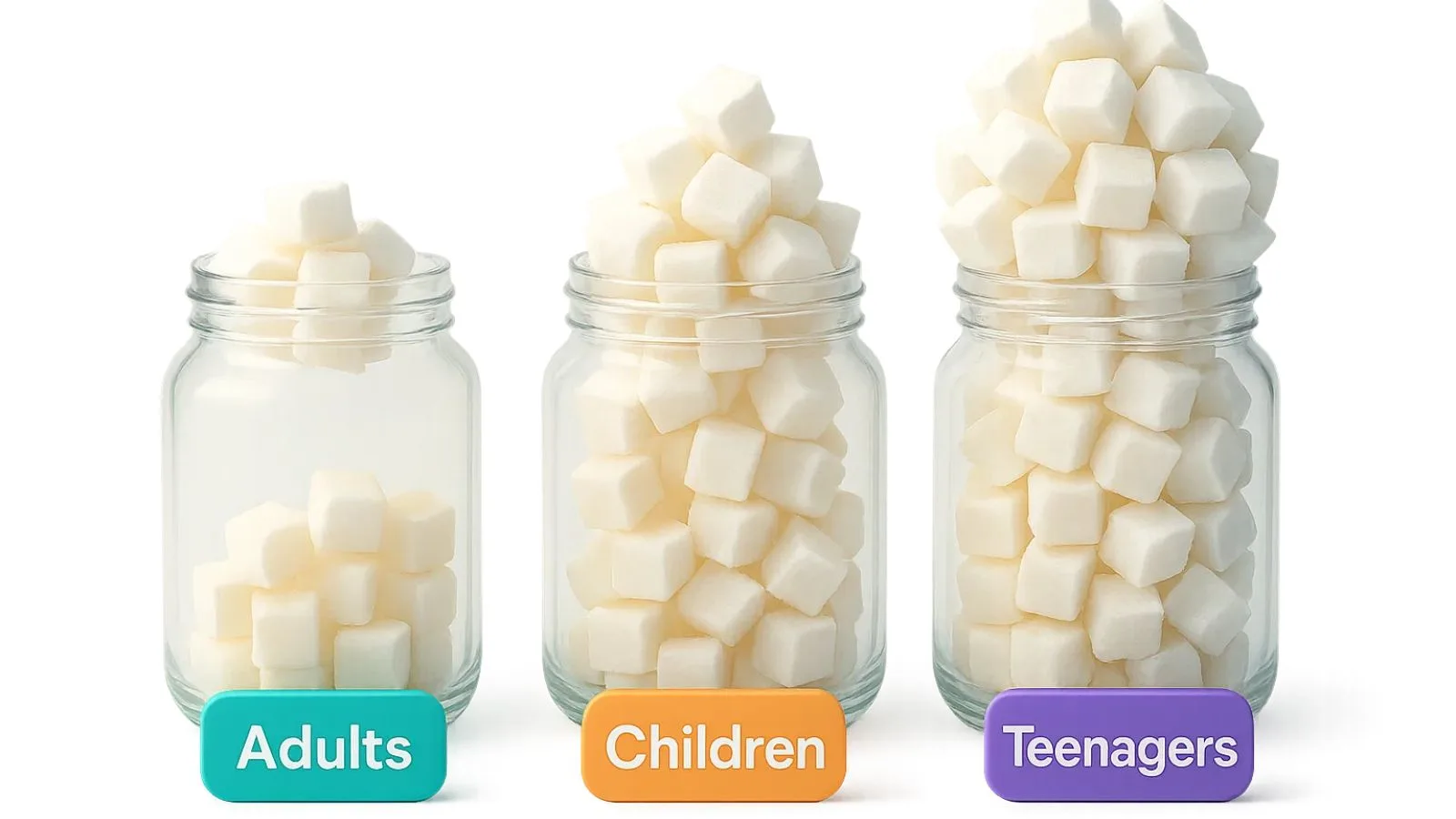
Health experts have set clear guidelines to help people understand their limits. According to the World Health Organization (WHO), the recommended daily sugar intake limit for adults is about 25–30 grams of added sugar per day. That’s roughly 6 teaspoons. Going beyond this regularly can increase your risk of lifestyle-related health issues.
For children, the safe range is even lower since their calorie needs are smaller. Experts suggest that sugar intake by age should be monitored carefully, with kids ideally consuming no more than 20–25 grams per day.
The reality, however, is that the average sugar intake per day in many countries is much higher than these recommendations. Sweetened drinks, packaged snacks, and hidden sugars in sauces and breads often push daily sugar intake far above the safe line.
So, when people ask how much sugar is safe per day, the answer is simple: try to stay below the recommended limit. Keeping track of added sugars in your meals and drinks can make a big difference in staying within the healthy range.
Recommended vs. Average Sugar Intake
| Group | Recommended Limit (grams/day) | Average Consumption (grams/day) |
| Adults | 25–30 g (≈ 6 tsp) | 60–90 g (≈ 15–22 tsp) |
| Children | 20–25 g (≈ 5 tsp) | 40–60 g (≈ 10–15 tsp) |
| Teenagers | 25–30 g (≈ 6 tsp) | 70–100 g (≈ 18–25 tsp) |
As you can see, most people consume 2–3 times more sugar than recommended. This gap is one of the main reasons behind rising cases of obesity, type 2 diabetes, and dental problems.
Also Read,
Sources of Sugar in Your Diet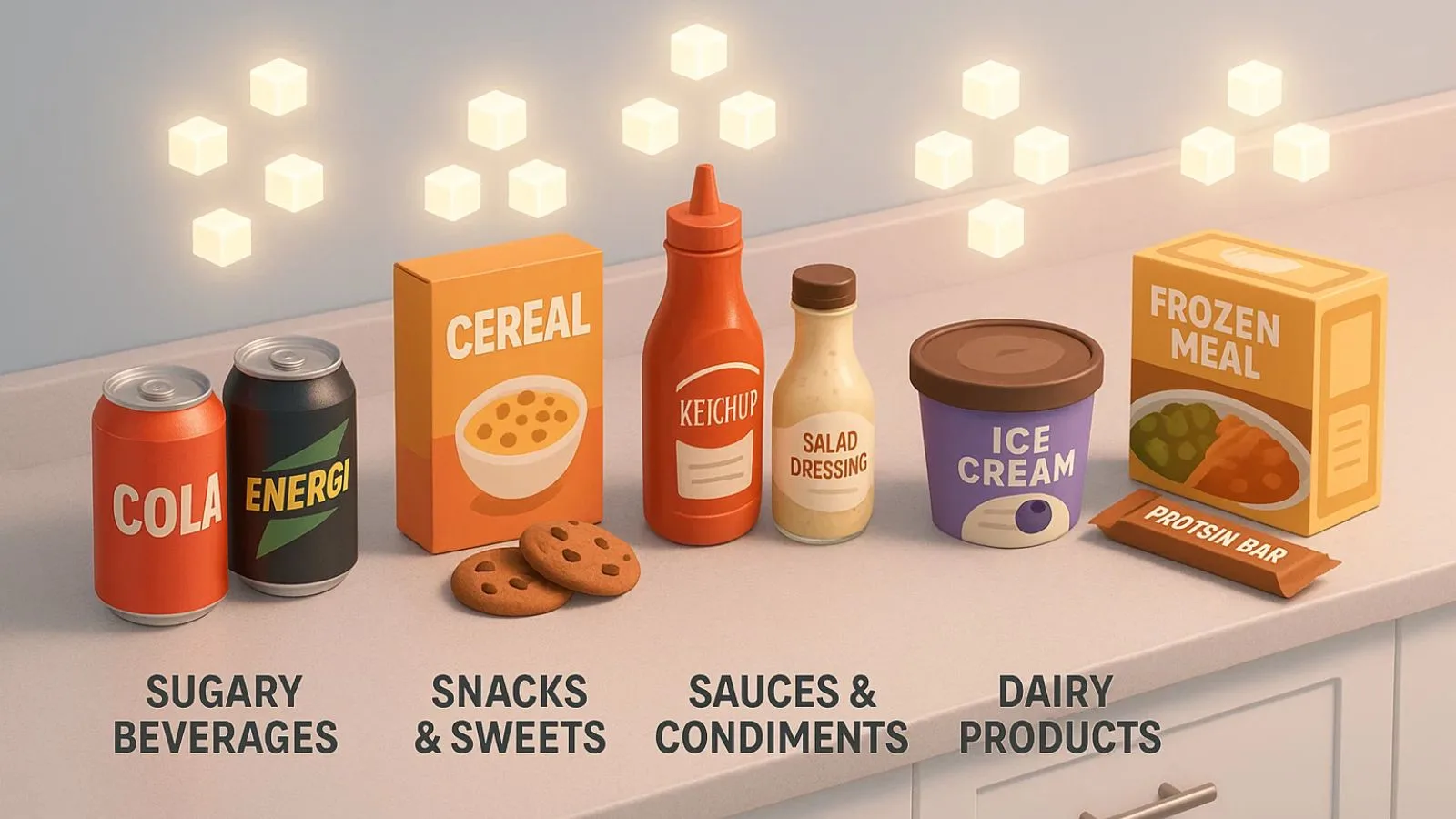
When people think about sugar, the first thing that comes to mind is desserts like cakes, chocolates, or ice cream. But the truth is, sugar hides in many everyday foods and drinks. Understanding where it comes from is the first step toward controlling how much sugar in a day.
Here are the main sources:
- Sugary Beverages – Soft drinks, energy drinks, sweetened teas, and flavored coffees are among the top contributors to excessive daily sugar intake. A single can of soda may contain more sugar than your entire daily limit.
- Packaged Snacks & Sweets – Cookies, candies, pastries, and breakfast cereals are obvious culprits. Many are marketed as “healthy” but still packed with added sugars.
- Sauces & Condiments – Ketchup, salad dressings, barbecue sauces, and even some breads contain surprising amounts of hidden sugar.
- Dairy Products – Flavored yogurts, milkshakes, and ice creams often come with added sweeteners.
- Processed Foods – Frozen meals, protein bars, and packaged soups can contain high sugar levels to improve taste and shelf life.
Many people don’t realize that a huge portion of their sugar consumption per day comes from these “hidden” sources rather than desserts. That’s why reading nutrition labels and tracking what you eat can help you stay within the recommended daily sugar intake limit.
Effects of Too Much Sugar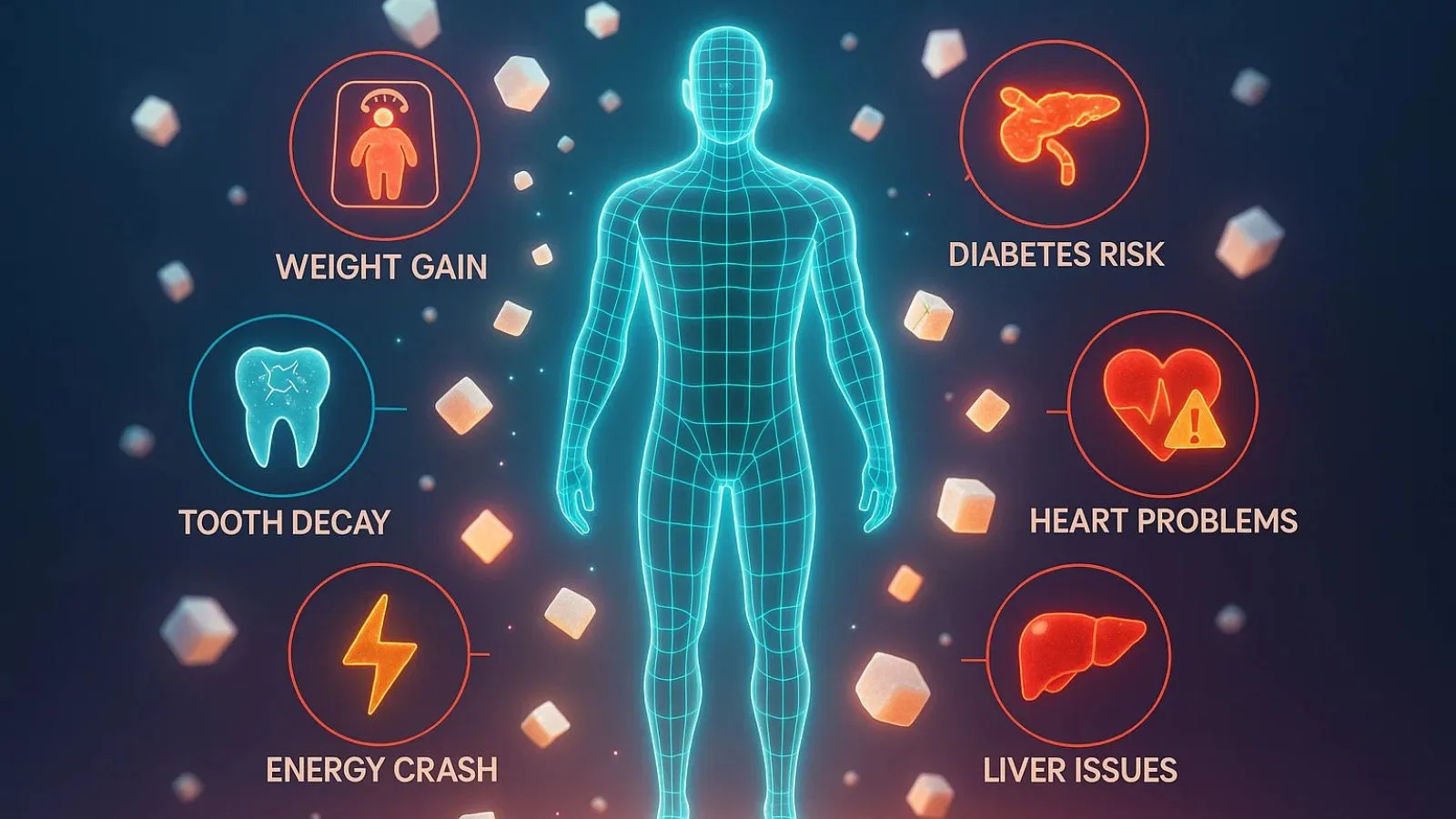
Exceeding the recommended limit of how much sugar in a day your body needs can cause more harm than you might expect. While a little sugar is fine, consistently going overboard can impact your health in several ways:
- Weight Gain & Obesity – High sugar intake often leads to excess calorie consumption. Sugary foods and drinks don’t keep you full for long, so you end up eating more, contributing to fat storage and weight gain.
- Increased Risk of Diabetes – Consuming more sugar than the daily sugar intake limit makes your body work harder to manage blood sugar levels. Over time, this can increase the risk of insulin resistance and type 2 diabetes.
- Heart Problems – Studies link high sugar diets to heart disease. Extra sugar raises triglycerides, blood pressure, and inflammation factors that harm cardiovascular health.
- Tooth Decay – Sugar feeds bacteria in the mouth, leading to cavities and gum problems. This is one of the most direct and visible effects of excess sugar.
- Energy Spikes & Crashes – Ever felt a quick boost after a sweet snack, followed by sudden fatigue? That’s the classic sugar crash, caused by blood sugar rising and falling too quickly.
- Liver Fat Build-up – Fructose, a type of sugar found in soft drinks and processed foods, can overload the liver, leading to fatty liver disease.
Simply put, consuming more than the safe limit of how much sugar is normal in a day can create both short-term discomfort and long-term health risks. The key is not cutting sugar out completely, but keeping it under control.
Also Read,
Easy Ways to Cut Down on Sugar Without Missing Out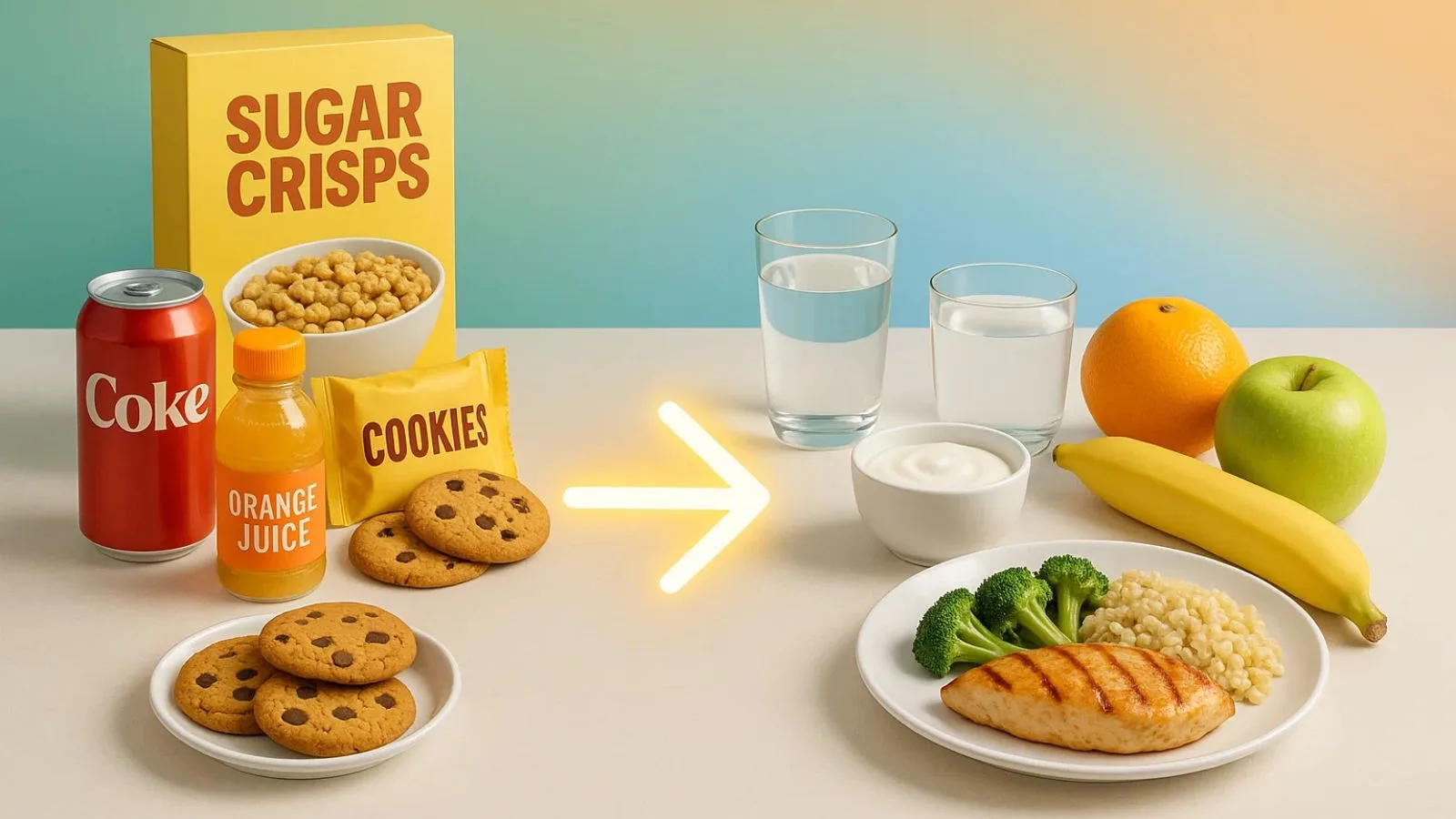
Cutting back on sugar doesn’t mean giving up all the foods you love. The goal is to stay within the safe range of how much sugar in a day your body needs, while still enjoying a balanced diet. Here are some practical strategies:
- Choose Natural Sweetness – Instead of sodas or packaged juices, opt for fresh fruits like dragon fruit. They provide natural sugar along with fiber, vitamins, and minerals.
- Read Food Labels – Sugar often hides under different names like corn syrup, dextrose, or maltose. Checking labels helps you spot hidden sugar and manage your daily sugar intake.
- Cut Back on Sugary Drinks – Switching to water, herbal teas, or sparkling water can reduce your sugar consumption dramatically.
- Go for Unsweetened Versions – Many products, like almond milk, yogurt, or cereals, have unsweetened options. They taste just as good once you get used to them.
- Control Dessert Portions – You don’t need to give up desserts completely. Try smaller servings or enjoy sweets occasionally instead of daily.
- Cook More at Home – Homemade meals give you better control over how much sugar you’re actually consuming compared to restaurant or packaged foods.
By making small changes, you’ll find it easier to stay within the recommended sugar consumption per day and still feel satisfied. Over time, your taste buds will adjust, and you’ll naturally crave less sugar.
Sugar Intake by Age – Do Kids and Adults Need the Same Amount?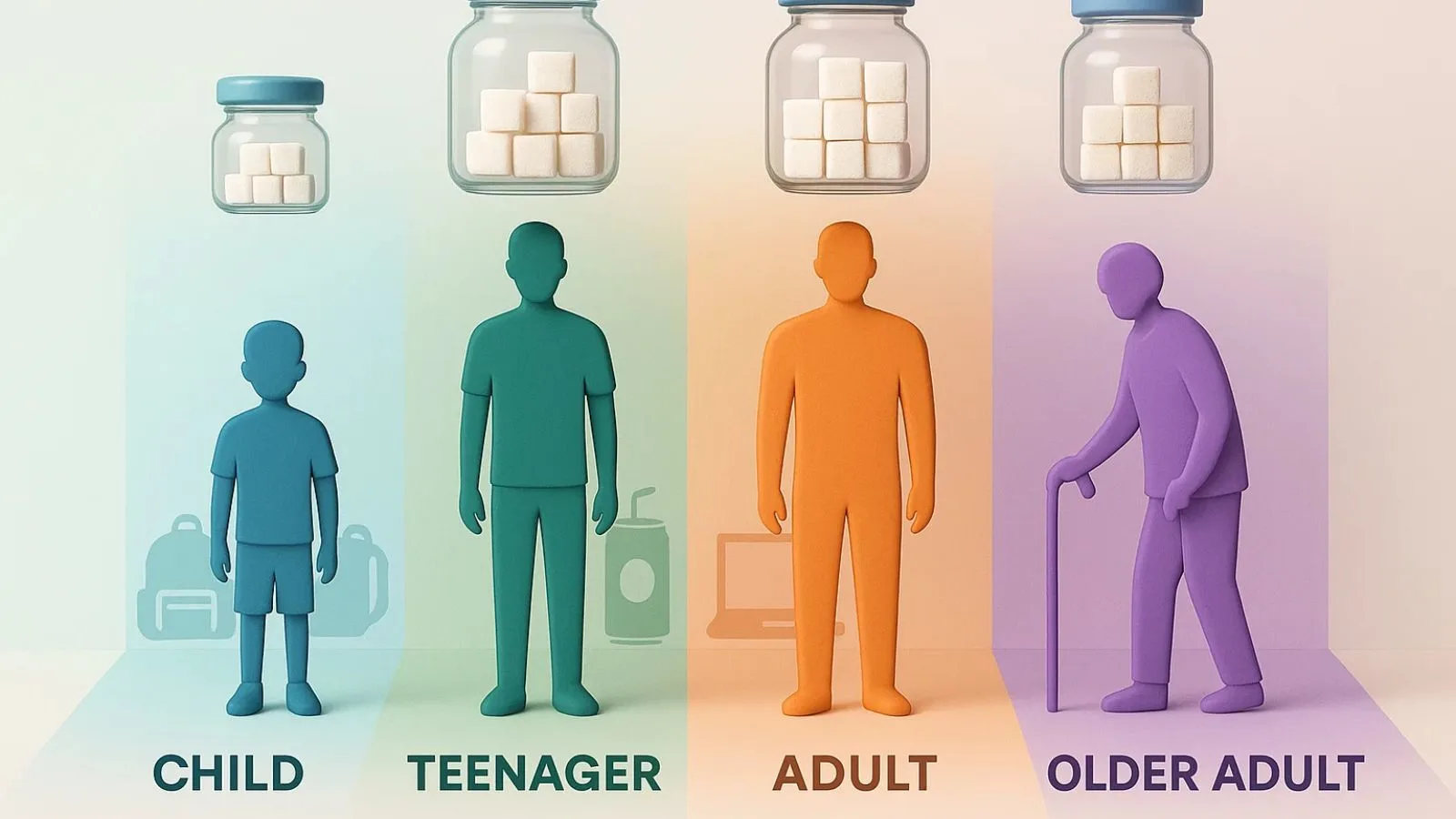
The amount of how much sugar in a day someone should consume isn’t the same for everyone. Age plays a big role because calorie needs and metabolism differ between children, teens, and adults.
- Children (2–10 years): Kids need less energy than adults, so their daily sugar intake limit is lower. Health experts recommend no more than 20–25 grams per day. Too much sugar at a young age can affect growth, lead to tooth decay, and increase the risk of obesity later in life.
- Teenagers (11–18 years): Teens tend to consume the most sugar because of sodas, candies, and fast food. The recommended safe amount is about 25–30 grams per day, but actual intake is often 3–4 times higher.
- Adults: For men and women, the average sugar intake per day should stay below 25–30 grams. This helps maintain energy balance and lowers risks of heart disease, diabetes, and weight gain.
- Older Adults: As metabolism slows, seniors should be even more careful about how much sugar is safe per day. Lower intake helps prevent chronic conditions and supports overall well-being.
By keeping an eye on sugar intake by age, families can build healthier eating habits that last a lifetime.
Tracking Your Daily Sugar Intake Made Easy
Knowing how much sugar in a day you consume is one thing; actually tracking it is another. With so many hidden sugars in packaged foods, sauces, and snacks, it’s easy to go over the recommended limit without realizing it.
That’s where a tool like CalorieTrackerBuddy.com comes in handy. It helps you:
- Track daily sugar intake alongside calories, protein, and other nutrients.
- Set personal goals based on your age, lifestyle, and health needs.
- Monitor progress over time so you can spot patterns and make improvements.
Instead of guessing, you’ll know exactly if your sugar consumption is within the safe range. This makes it easier to stay consistent and reduce risks linked to excess sugar.
If you’ve ever wondered, “Am I going over the daily sugar intake limit without knowing it?” Calorie Tracker Buddy can give you the answer in seconds.
Final Tips for Managing How Much Sugar in a Day You Consume
By now, you know the importance of keeping track of how much sugar in a day you actually eat. Still, making it a habit can feel challenging at first. Here are some final tips to keep things simple and sustainable:
- Start Small – Instead of cutting out sugar all at once, begin by reducing sugary drinks or replacing one dessert a week with a healthier option.
- Watch Out for Hidden Sugars – Check ingredient lists for words like corn syrup, sucrose, or maltose. These are just other names for sugar.
- Balance Your Plate – Pair carbs with protein and fiber to avoid blood sugar spikes and crashes.
- Plan Ahead – Keep healthy snacks like nuts, fruits, or yogurt on hand to resist sugary temptations.
- Use Tech to Help You – Apps like CalorieTrackerBuddy make tracking daily sugar intake much easier.
The goal isn’t to completely avoid sugar; it’s to enjoy it in moderation while staying within the safe range of how much sugar is normal in a day. Small, mindful changes can lead to big health benefits over time.
![]()
Conclusion
Understanding how much sugar in a day is safe for your body is one of the simplest ways to protect your long-term health. While sugar isn’t something you need to eliminate, keeping it within the daily sugar intake limit can help you manage weight, boost energy, and reduce the risk of chronic diseases.
The key is awareness, knowing where sugar hides, tracking your intake, and making small, realistic changes to your eating habits. With tools like CalorieTrackerBuddy.com, staying on top of your sugar consumption per day becomes much easier, helping you live healthier without feeling deprived.
FAQs
- How much sugar is safe for adults to consume in a day?
Most health experts recommend keeping your sugar intake to about 25–30 grams daily, which is roughly 6 teaspoons. Sticking to this guideline can help reduce the chances of obesity, diabetes, and heart-related issues. - What’s a normal sugar intake for kids?
For children, the safe amount is generally around 20–25 grams per day. Since kids require fewer calories, it’s important to keep a close eye on their sugar consumption as they grow. - What if I regularly exceed my daily sugar limit?
If you consistently go over the recommended sugar intake, you might face weight gain, energy dips, insulin resistance, and an increased risk of chronic conditions like diabetes and heart disease.